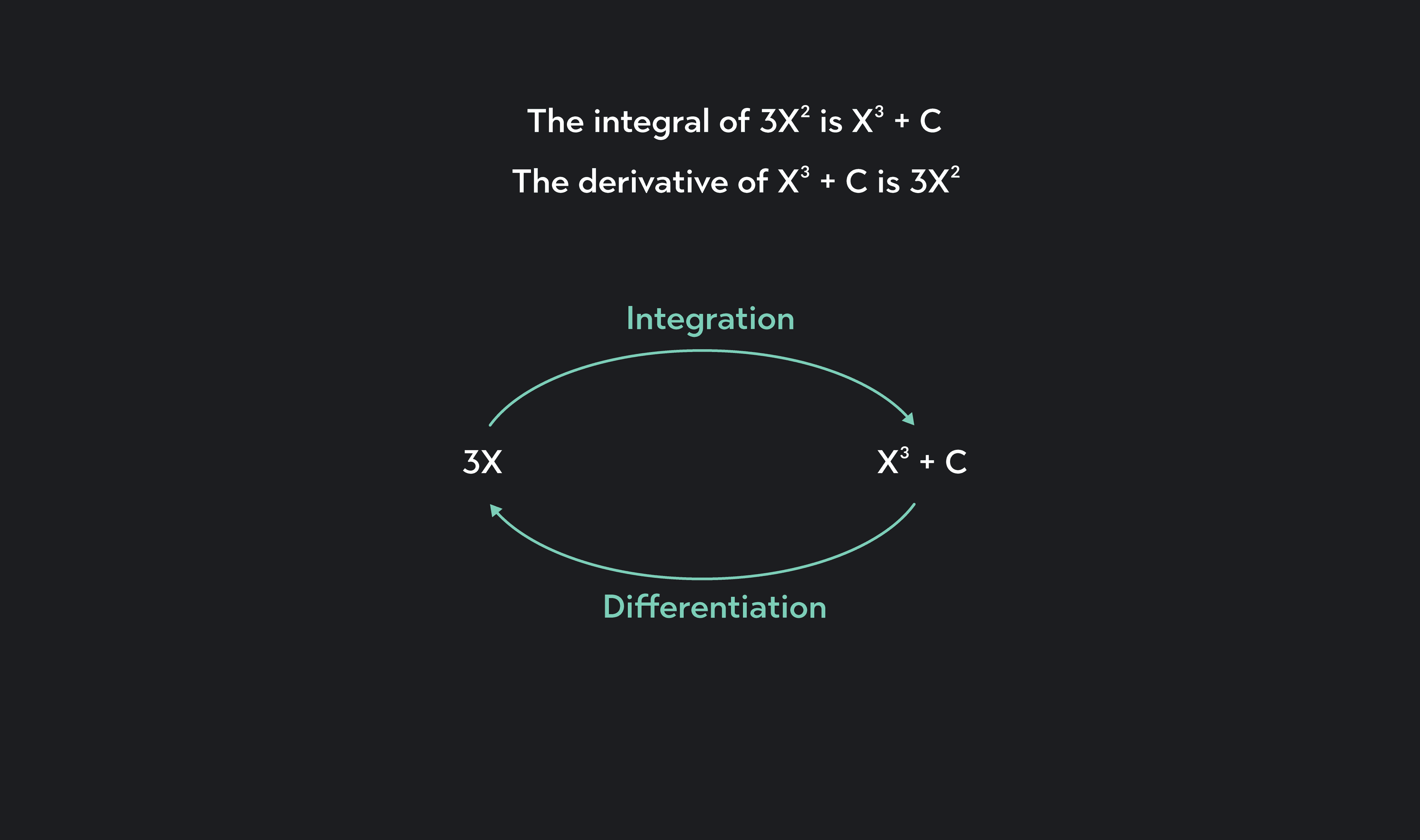
Calculus
Best Integral Shortcuts: Solve & Master Integrals
Learn how to integrate quickly with these integration shortcuts.
Rachel McLean
Subject Matter Expert

Calculus
08.18.2022 • 8 min read
Subject Matter Expert
In this article, we review the definition of the integral. We discuss the most important integration rules to know and apply these rules to four primary methods of integration. Using examples, we practice integrating these four techniques.
In This Article
Differentiation finds the instantaneous rate of change of a function. Integration finds the reverse of a derivative, called the antiderivative. Integration can be conceptualized as the reverse process of differentiation.
Together, differentiation and integration constitute the fundamental operations of calculus. Their relationship is explained by the fundamental theorem of calculus.
There are two types of integrals: indefinite integrals and definite integrals. Indefinite integrals find antiderivative functions. Definite integrals calculate areas under the curve on a specific interval.
The notation for an indefinite integral is given below:
An indefinite integral finds the antiderivatives of , which are usually denoted by . Taking the derivative of outputs back , which explains why is called an antiderivative function. For this reason, integration is also sometimes referred to as anti-differentiation:
For example,

The symbol is called the integral sign, and is called the integrand. The capital letter is called the constant of integration. is used to represent any constant value.
Remember that taking the derivative of the antiderivative of gives back itself. No matter what constant value holds, the derivative of will always be zero. So, when we take the derivative of , we always get back alone. Thus can take any value, and for this reason, the notation represents an infinitely large family of all antiderivatives of the function .
The first fundamental theorem of calculus guarantees the relationship described earlier. If is a continuous function on an interval containing , then we can define by:
Then and so is an antiderivative of :
Now, let’s review the notation for a definite integral:

represents the area under the curve on . To approximate this area, we could create rectangles of equal width that approximate the curve, and then take the sum of their areas. This approximation is called a Riemann sum. However, this sum either overestimates or underestimates the area under the curve.
By taking the limit of the Riemann sum as the number of subdivisions approaches infinity, we obtain the precise area under the curve. This defines a definite integral.
The second fundamental theorem of calculus clarifies the relationship between the integral and the antiderivative function. This theorem tells us that we can find the definite integral of a function on by taking the difference between the indefinite integral of the function evaluated at and the indefinite integral of the function evaluated at .
For a good overview of this theorem, Dr. Hannah Fry shares what this theorem actually means, how it’s calculated, and what it can further allow us to do:
Now that we’ve defined integrals, it’s important to know how to evaluate them. These integration formulas are used in every method of integration, so it’s a good idea to memorize them.
for some constant
Power Rule: for some real number
for some constant
Dr. Tim Chartier covers core differentiation rules and examples of how to use them:
, for any positive real number
For these rules, assume that is in radians.
for some real number
for some real number
We’ll discuss four essential techniques of integration:
Integration by u-substitution
Integration by parts
Integration by partial fractions
Integration using trigonometric identities
U-substitution is used to integrate composite functions. U-Substitution reverses the chain rule. For this reason, u-substitution is also called the reverse chain rule. To use u-substitution, we rewrite our integral in terms of and :
We can use the four steps below for integration by substitution:
Pick one part of the integrand to represent . Usually, is equal to , the inner function of the composite function.
Differentiate to find . If necessary, rearrange the problem algebraically so that perfectly matches what’s left inside the integral.
Substitute and into the integrand, and integrate. If taking a definite integral, redefine your limits of integration in terms of .
If taking an indefinite integral, substitute the original values back into the resulting function and add the constant of integration to your final answer. If taking a definite integral, simply evaluate using the new limits in terms of .
For example, let’s evaluate . Let , so that . Substituting and into the integrand, we get:
Integration by parts is used to take the integral of a product of functions. Integration by parts uses the formula below, which is derived directly from the product rule for derivatives:
We can use the four steps below to integrate by parts:
Choose and to separate the given function into a product of functions. Generally, is the term that’s easiest to differentiate, and is the term that’s easiest to integrate.
Differentiate to find , and integrate to find .
Plug , , and into the integration by parts formula.
Solve and simplify where needed.
For example, let’s evaluate . Let and . Differentiating , we find that . Integrating , we find that . Plugging , , , and into the integration by parts formula, we get:
The acronym LIATE can help you decide which term to designate as . LIATE stands for:
Logarithmic functions
Inverse trigonometric functions
Algebraic functions
Trigonometric functions
Exponential functions
Function types that sit the highest on this list should be prioritized as .
Integration by partial fractions is used to integrate rational functions. A rational function is an algebraic fraction where both the numerator and denominator are polynomials.
We can use the nine steps below to integrate by partial fractions:
Factor the denominator of the function.
Decompose the function into a sum of its parts by assigning an unknown variable to each term of the denominator.
Combine all terms into one by finding the common denominator, making sure you multiply each numerator appropriately.
Multiply out the numerator.
Set up an equation that equates the terms of the original function’s numerator with the terms in your new equation’s numerator.
Set up a second equation that equates the constant terms of the original function’s numerator with the constant terms in your new numerator.
Solve for the unknown variables.
Plug your solved variables into Step 2.
Integrate using the reciprocal rules.
For example, let’s evaluate . First, we’ll factor the denominator. Then, we can proceed with steps 2 through 4.
Now,
Our next step is to solve for and using steps 5 through 7. Our first equation is . We can simplify this equation to . Our second equation is . This gives us a system of equations, which outputs that and .
Using steps 8 through 9, we have:
This technique is also called partial fraction decomposition.
Here are some of the most important trigonometric identities to know:
You can use trigonometric substitution with the above identities to help solve tricky integrals involving trigonometric functions.
For example, let’s evaluate
With the world’s most engaging instructors, Outlier’s calculus course offers a cinematic and immersive curriculum that prioritizes student success. It’s an affordable route to improving your mastery of integral calculus.
Outlier offers accessible college classes at a fraction of the cost — 80% less expensive than traditional college!
Earn 3 college credits towards your degree for every course you complete. Credits are received from the University of Pittsburgh, a top-60 school.
Calculus courses are interactive and taught by world-renowned math professors, including Tim Chartier of Davidson College, Hannah Fry of University College London, and John Urschel of MIT.
Course resources include question sets, quizzes, and an active-learning-based digital textbook. You’ll also have access to free tutors and a study group.
Transferring credits is easy.
If you do the work and don’t pass, you’ll receive a full refund.
Exam windows are flexible, and lectures are viewable on-demand, anywhere.
Outlier (from the co-founder of MasterClass) has brought together some of the world's best instructors, game designers, and filmmakers to create the future of online college.
Check out these related courses:

Calculus
Learn how to integrate quickly with these integration shortcuts.
Subject Matter Expert

Calculus
In this article, we’ll discuss the definition of the derivative, and learn what the derivative represents. We’ll examine three different ways to conceptualize derivatives, including instantaneous rates of change, the slope of the tangent line, and velocity.
Subject Matter Expert

Calculus
What is the product rule? Learn how to use the product rule to calculate derivatives of products. Then, explore how we derive the product rule, and test your mastery with examples.
Subject Matter Expert